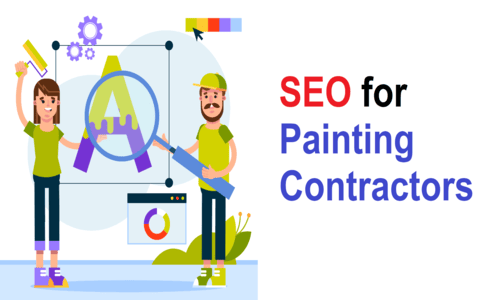According to BrightLocal, 66% of people trust Google to research local businesses online, and 36% prefer going directly to a company’s website.
Now let’s see how this works for painting contractors. If you’re not showing up in these searches, you’re not just missing traffic. You’re missing out on opportunities to book more projects. And while you’re invisible, your competitors are scooping up those high-quality leads.
The solution? SEO for painting contractors. With the right SEO strategy, you can rank higher on search results, attract leads that actually convert, and ultimately grow your painting business.
This guide explains the best SEO strategies for painters to show up on Google’s No. 1 page and win more painting jobs!
What is SEO for Painters?
SEO for painters is a strategic process of making your painting business rank higher in searches on Google and other search engines. The goal is to make your website appear near the top on the first page of search results whenever a customer searches for services like yours.
Typically, SEO for painting companies includes the following strategies:
- Local SEO: Appear in nearby searches with maps and reviews.
- On-page SEO: Optimize website pages with keywords and clear content.
- Off-page SEO: Gain authority through backlinks and online mentions.
- Technical SEO: Improve site speed, mobile use, and structure.
- Modern Trends in SEO: Adapt to voice search, AI, and Google updates.
Let’s review each in detail in the following sections.
Local SEO for Painting Contractors
Local SEO helps your site show up when people in your area search for services like “house painter near me” or “painting contractor in (your city)”. So, if your business is located in Orlando, and someone types “exterior house painter Orlando” into Google, a strong local SEO ensures you appear in the top three local listings as well as in organic results.
Key strategies in local SEO for painters include the following.

1. Optimize Google Business Profile
Google Business Profile (GBP) is a free tool from Google that includes comprehensive details about your local painting business. It is your business listing that shows up on Google Maps and local search results.
Why does it matter? Research by SOCI shows that 50% of American consumers aged 25-34 rely on Google Maps to find local businesses. And according to Google, people are 70% more likely to visit and 50% likely to purchase from companies with a complete Business Profile.
To optimize your Google Business Profile:
- Claim & verify your Google Business Profile on Google’s business site.
- Select categories. Use “Painter,” “House Painter,” or “Painting Contractor” as your main category.
- Complete all fields. Services, service areas, hours, website, and phone.
- Add quality photos. Before/after projects, team shots, or branded vehicles.
- Post weekly. Share promotions, offers, or recent work.
2. Include Local Keywords
Local keywords are basically the search terms that connect your service to a specific location. Why is it important? Data from Backlinko shows that 46% of searches on Google have a local intent. The idea is simple. You want to show up when people nearby are actively searching for painting services.
But, how do you find these keywords? Free platforms like Google Keyword Planner are a great place to start. You can also utilize expert painter SEO services that understand your industry standards. A common approach is to take your primary keyword and pair it with the name of the city or region you serve. For example, if your main keyword is “interior painting” and you’re targeting Florida, you’d go with “interior painting in Florida.”
3. Reviews and Testimonials
Written feedback doesn’t just influence buyers. It also shapes how Google views your business. In fact, a survey from local SEO experts shows that High Numerical Google Ratings, like 4-5, is the 6th most influential local pack/finder ranking factor. Google pays close attention to the authenticity, quality, and frequency of reviews. That’s how it decides whether your business deserves a higher spot in local search results.
To optimize reviews in SEO for house painters:
- Use follow-up emails to request reviews. Offer perks like discounts or loyalty points as incentives.
- Acknowledge positive reviews to build goodwill and repeat business.
- Respond promptly to negative reviews with solutions. Show commitment to customer care.
- Showcase great feedback on your website and social media to strengthen brand credibility.
4. Directories and Citations
Directories are online places where your business is listed, such as Angi, Yelp, or Houzz. Think of them like modern-day phone books on the internet. These listings make it easier for people to find and mention your business online (called citations).
Winning citations are a critical component in SEO for a painting company. The more often Google sees your painting business listed in trusted places, the more confident it is that your company is reliable. As a result, your site gathers more authority and ranks higher in search results.
5. NAP Consistency
NAP is the shorthand for your company’s name, address, and phone number. SEO for painters and decorators requires that these elements remain the same across all online mentions and listings of your business. Why? Consistent NAP tells Google that the information it has on your business is correct and reliable enough to show in search results. Meanwhile, inconsistent NAP details can confuse customers and suggest that your business is not trustworthy.
On-Page SEO: Improving Your Website to Rank Higher
On-page SEO is the next step in any painter and decorator SEO strategy. It focuses on improving the pages of your website so that Google understands exactly what services you offer. Unlike local SEO, these strategies expand beyond regional searches to target broader search terms and user intents.
When optimizing on-page elements, you need to focus on the following factors.

1. Keyword Research
Keywords are the exact phrases your ideal customers type into Google when they’re looking for painting contractors. Google uses those keywords to decide whether your page should show up in search results. When looking for keywords, consider:
- High search volume
- Low keyword competition
- Primary keyword (describes your business’s overall niche)
- Secondary keywords (semantic terms, supporting the primary keyword)
- Long-tail keywords (descriptive phrases or questions with a specific intent)
2. Optimizing Content
Once you have your search terms, it’s time to create content around them. Start by creating content for your service pages. The aim is to help Google and people know what your page is about so it can rank for searches.
Blogs are also a powerful way to target broader search intents with more comprehensive information. You can create content for blogs using long-tail keywords. For example, if people are searching “How often should you repaint a house exterior?”, you can write a post breaking it down by climate, materials, and paint quality. This kind of comprehensive content gives you more credibility and portrays you as the go-to expert in the industry.
When creating content using SEO for painting contractors:
- Add your primary keyword naturally in the main headings and body content.
- Use Header Tags like H1 > H2 > H3 to make your content easy to crawl.
- Link to related pages of your site. Use descriptive anchor text to provide content.
- Give your images a keyword-rich description so Google understands what it’s about.
Calls-to-Action (CTAs)
Calls to action are simple prompts that guide people to take the next step, whether that’s using your service or buying your product. Include a clear CTA in every section of your service pages. Make it specific, straightforward, and easy to click.
Phrases like “Take your home interior to the next level” may sound fancy, but they don’t really tell what the user needs to do. Instead, you can say to “Get a Quote,” “Sign up,” or “Book a Painting Consultation.” And avoid over-the-top, salesy language. Keeping your CTAs professional helps build trust in your brand.
Off-Page SEO: Get Other Sites to Recommend You
Off-page SEO means all actions you take beyond your website in an effort to increase your search rankings. Some core activities include earning backlinks, driving branded searches, and increasing engagement on social platforms.
1. Earn High-Quality Backlinks
Backlinks are a link-building strategy where other websites use links in their content to point back to yours. The more trusted and relevant those websites are, the better. You can earn these by writing guest articles, creating helpful content that others want to share, or reaching out when you see a broken link and suggesting your content as a replacement.
2. Take Advantage of Social Signals
Social media likes, shares, and comments don’t directly affect your Google ranking, but they spread your content to more people. The more visibility you get, the higher the chance that others will mention your brand or link to your site later.
3. Boost Your E-E-A-T
EEAT stands for Experience, Expertise, Authority, and Trust. This is Google’s way of measuring how trustworthy you look online. To build it, get your brand or team mentioned on credible sites. You can also collect positive reviews and show proof that you know what you’re talking about.
4. Drive Branded Searches
Encourage people to search for your brand name directly on Google. This tells Google that people are looking for you specifically. Campaigns, videos, or content that make your brand memorable can help you drive this type of search behavior.
Technical SEO: Improve Your Site’s Page Experience
Technical SEO involves improving your site’s technical aspects such as design, speed, navigation, and security. It aims to help search engines find information and index your website. It also provides a seamless experience to users so they stay on your site and take action.
Here’s how technical SEO works.
1. Optimize for Mobiles
Data from Global Stats shows that 59.1% of internet traffic comes from mobile devices. As a result, Google has adopted a mobile-first indexing approach. This means it prefers how well the mobile version of your site works to decide whether to rank it in search results. Moreover, most people use mobile devices to search for information online. Therefore, optimizing your painting website for mobiles is non-negotiable.
2. Improve Your Page Speed
Research from Portent shows that a webpage that loads in 1 second has a 3 times higher conversion rate than one that takes 5 seconds. Speed is also part of Core Web Vitals, which are factors in Google’s “page experience” ranking signals.
To optimize loading speed:
- Compress large images on your site. They take less time to load.
- Use a CDN or content distribution network. Connects users to the nearest server or copies of webpages so they take less time to load.
- Minify JavaScript, CSS, and HTML files. Removes whitespace and reduces file sizes.
Keeping Up with Modern SEO and New Search Trends
Search engines are getting more intelligent with the continuous updates and the introduction of AI. Knowing how the trends are shifting can help you adjust your modern SEO strategies and stay visible in online searches. Here’s what to do.
1. Optimize for AI Searches
From Google’s AI Overviews and AI Mode to ChatGPT and DeepSeek, AI search algorithms are changing how your customers find your business and visit your website. Optimizing your content to these searches can help you show up right where your customers are.
To optimize for AI searches:
- Focus on semantic search or the context behind the query rather than keywords.
- Include schema markup to help AI understand what you’re writing.
- Use a natural conversational tone that AI systems can understand easily.
- Create first-party content around Google’s E-E-A-T standards.
2. Create Video and Interactive Content
Video and interactive formats can drive engagement and ROI far more than text alone. Data from Wyzowl shows that video marketing gives 93% marketers a positive ROI. Invest in short and personalized video prospecting. Use video to demonstrate your products or services.
3. Adapt to Voice Searches
Voice searches are about natural and conversational queries. Why does it matter? Because 35% of U.S. households now own a smart speaker. It is shaping how customers discover and interact with businesses.
To optimize for voice searches:
- Focus on long-tail keywords and conversational writing style.
- Use FAQs that match how a customer would speak about it.
- Ensure local SEO is strong for “near me” searches.
Final Words
If you want to land more painting projects, you need to show up in Google’s top search results by utilizing SEO for painting contractors. It’s because your customers are searching for painting services online. The best way to get the most bang for your efforts is to utilize expert SEO services for painters.
At PNC Logos, our team of SEO experts understands the nitty-gritty of your painting industry needs and target customers. If you want to gather more traffic and land more painting jobs, contact us now to get started





